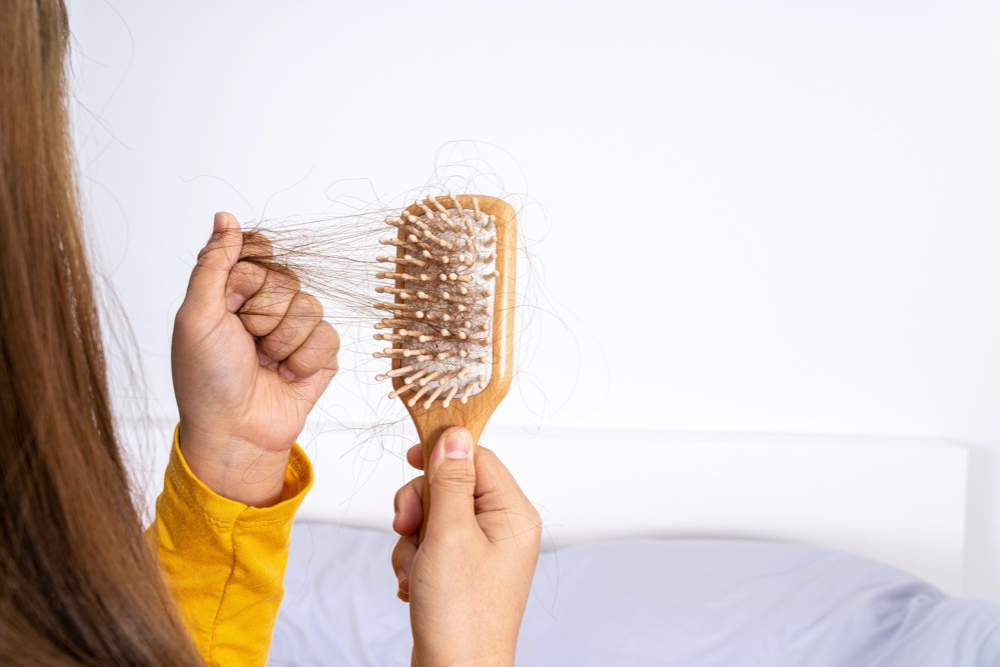- Fast results
- 4,000+ locations
- 4.8 star rating
Need Help? (888) GET LABS


Not many people know that iron deficiency can lead to female hair loss. After all, hair loss or alopecia is more directly associated with hormonal changes and certain diseases. But if you look closely at how hair grows, it is clear that insufficient iron triggers hair loss.
Iron plays a crucial role in the production of hemoglobin – the protein that carries oxygen to the different cells in the body. So when there’s insufficient iron, there will most likely be scarce oxygen for cells to function. This affects the cells that stimulate hair growth and keeps the hair follicles healthy enough to hold hair.
While hair loss is more prominent among men, women are not an exception to the condition and even pattern baldness. According to the Academy of Dermatology Association, women lose between 50 to 100 strands of hair per day.
Additionally, it has been reported that around 30 million women in the US suffer from female hair loss. Also, hair loss is not exclusive to the scalp but also to other body parts where hair grows. Plus, it can be temporary or permanent.
Hair is the crowning glory for women, so it can be frustrating for females and can impact their emotional and mental well-being.
It’s easy to think that hair loss is simply hair falling off your head. However, the severity of the condition can be determined by the volume, area, frequency, and amount of hair being shed off. In addition, you can tell about hair loss through the following signs.
Loosening hair: This is evident when you get clumps or a handful of hair when combing or gently tugging. You’ll also see more hair loss during washing or after a shower.
Gradual thinning: This typically occurs on top of the head. Men genetically inclined to baldness often observe thinning on the frontal scalp. Women, on the other hand, may experience thinning on the part line due to androgenetic alopecia.
Patchy bald spots: Circular bald spots could appear on the head, eyebrows, and other body parts. This is a typical pattern for older women and a prominent symptom of alopecia areata.
Aside from these patterns, women with underlying conditions or medical treatments will most likely experience localized or total hair loss.
For example, those undergoing chemotherapy typically lose a considerable portion, if not all, of their hair during the procedure. On the other hand, people with ringworm infection on their scalp also experience hair loss and other symptoms like redness and swelling.
However, you’ll observe either hair loosening or gradual thinning with iron-deficiency-related hair loss. So Still, it’s best to consult your doctor for proper diagnosis through blood tests for alopecia.
Like any other cell, the hair follicles require oxygen to stimulate hair growth, repair skin damage, and create new blood vessels if necessary.
The oxygen is delivered by the red blood cell through a specialized protein called hemoglobin. To produce hemoglobin and RBCs, in general, iron is needed as it is a core requirement to build a hemoglobin component known as heme.
As a result, if you have an iron deficiency, the hemoglobin will not be properly formed, affecting the function of the RBCs to transport oxygen, which in turn impedes the hair from growing and keeps it from falling.

Iron deficiency justifies the role of diet in hair loss. Therefore, healthcare providers often request patients to undergo an iron blood test as part of the diagnostic stage of the hair loss treatment.
Similarly, those diagnosed with iron-deficiency anemia are advised to check for hair loss and whether or not the treatment has improved the condition.
If you suspect iron-deficiency anemia, look for the following symptoms:
When the cause is caught early, you’ll have a fair chance of treating female hair loss before it’s too late. Unfortunately, hair treatment can only do so much when baldness is permanent. Still, if that’s the case, you can opt for a hair transplant.
But for hair loss related to iron deficiency, the solution is as simple as adjusting your diet or taking supplementation. Addressing the insufficient iron in your system allows for healthier hair follicles that promote hair growth. High-protein foods and vegetables are often the go-to sources of iron.
Include these foods in your staple diet:
For other treatments, you can refer to the following:
PRP is the new hair-growth technique that has been used and regarded as an alternative solution for female baldness with low morbidity and cost.
Having iron-deficiency anemia is one of the most common causes of hair loss. Therefore, seeing a doctor and taking an iron blood test can help identify if iron deficiency drives the condition.
By seeking proper testing, your doctor can lead you to appropriate treatment. Nonetheless, you can speed up the healing and regain healthy hair by changing your lifestyle and taking the proper supplement.
Our TIBC blood test screens the amount of iron in the blood. It also evaluates the blood cell’s capacity to bind with the mineral.

© Copyright 2025 Personalabs. All Rights Reserved.